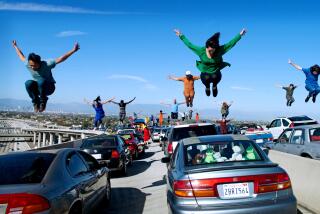DISCOVERIES
WILD L.A.: A Celebration of the Natural Areas n and Around the City
By James Lawrence
Sierra Club Books: 192 pp., $40
We need “Wild L.A.” in Los Angeles. We need to be reminded of the nature and wilderness still available to us. Like people who live in cities everywhere, we need help refocusing, so that we can see the peregrine falcons flying between buildings or identify the palms lining the boulevards. We may not have four noticeable seasons, but we have a jacaranda season and a poppy season, and we have natural phenomena like the Santa Anas that affect our breathing and our moods.
James Lawrence has written a celebration. Los Angeles, he writes, boasts the largest amount of parkland within city limits of any city in the country. He does not venture very far into the inner city, East L.A. or South-Central to find the remnants of wildness, or even to my own neighborhood, Venice Beach (“where the debris meets the sea”). He hugs the perimeter, where there is, in all fairness, more wide open space. There is no pollution in these photographs, which gleam in brilliant blues and verdant greens. One or two sunsets have that suspiciously brazen range of colors--perhaps the effects of sulfur dioxide and carbon monoxide--but, other than that, porpoises leap and flowers bloom toward the glistening sun. You might not recognize the L.A. you know and struggle with, but you will be drawn to explore it by these beckoning photographs.
Lawrence walks us through the Santa Monica Mountains, where “twenty-six distinct natural communities support a variety of habitats for more than fifty-three species of mammals and nearly four hundred species of birds, including thirteen nesting species of raptors.” He dips into the geology, the biology and cultural histories briefly, as well as some of the environmental struggles currently underway, such as the Ahmanson Ranch development, north of Calabasas. Lawrence frequently points out not only areas of “unscarred purity” but also the miracle of their “accessibility from nearby Los Angeles.” It’s important to believe in, and, if we’re lucky, hold a memory of wilderness that is pristine, but the photos, in all their clean perfection, make these areas seem remote. This works against Lawrence’s point that these areas are close to where we work and shop and complain about a lack of wilderness.
One chapter on parks along the rim of the San Fernando Valley and glowing descriptions of Happy Camp Canyon Regional Park (part of the Rim of the Valley Trail Corridor, 450,000 acres administered by the Santa Monica Mountains Conservancy) open up new horizons in a commuter’s world. Lawrence takes us to the Rancho Mission Viejo Land Conservancy Wilderness areas; through the Santa Ana Mountains on the eastern border of Orange County; through the San Gabriel Mountains; the Sepulveda Basin Wildlife Reserve in the San Fernando Valley and Abalone Cove on the Palos Verdes Peninsula. Your own impressions of these places, however, may not live up to Lawrence’s. There have been times when Abalone Cove was laced with garbage and oil slicks covered the tide pools, and there have been days when “quaint, lovely” town of Avalon on Catalina Island was crowded and noisy.
I prefer the photographs of individual species to the broad vistas perhaps because many of the species echo L.A.’s particular stylishness. Take the American kestrel, a Southern California raptor in shades of rust and blue; or the Western ringneck snake, more like an M.C. Escher print than an animal; or the gnarled oaks and the smooth-barked, red-skinned manzanita, perched on cliffs and hillsides. These species, seen so close and splendid, look brazen and whimsical and full of the light of their particular ecosystems: desert sun or leafy shadows or coastal fog.
The parks that Lawrence writes about and photographs have been hard-won, and seem, though some are tens of thousands of acres, like a precarious necklace on a black velvet background, strung together by committed conservationists or those wealthy enough to protect their land.
But Lawrence believes there are still places you can go inside L.A. and find quiet or go eye-to-eye with a mountain lion who decides to let you live. Somewhere between 3:30 and 4:30 a.m., it’s true, along the coast, you can hear the surf over street noise. In that one hour each morning, our ecosystem is as pristine as it gets.
There were many losses in Los Angeles that Lawrence refers to in the text (companion volumes perhaps to this one, though coffee table books that serve as records of destruction are probably not all that popular). These include the L.A. River, the Playa Vista project underway at the Ballona Wetlands, the Laguna Canyon Toll Road, the wild parts of Orange County, perhaps more poignant, more tragic, because of the beauty and diversity they drove away. One worries that without the images of these losses in our collective memory, we’ll plunge ahead on the road already taken.
More to Read
Sign up for The Wild
We’ll help you find the best places to hike, bike and run, as well as the perfect silent spots for meditation and yoga.
You may occasionally receive promotional content from the Los Angeles Times.






